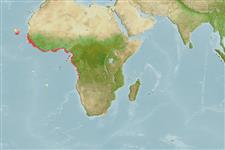>
Carangiformes (Jacks) >
Carangidae (Jacks and pompanos) > Caranginae
Etymology: Caranx: French, carangue, the name of a Caribbean fish; 1836 (Ref. 45335); fischeri: Named for Dr. Walter Fischer (1929-2023), for his vision and dedication in initiating the Species Identification and Data Programme of the Food and Agriculture Organization of the United Nations (Fischer, 1989), which in numerous ways, this program has been an invaluable resource for marine fisheries biologists and ichthyologists.
Eponymy: Dr Walter Fischer worked for the Marine Resources Department of the UN Food and Agriculture Organisation. [...] (Ref. 128868), visit book page.
Environment: milieu / climate zone / depth range / distribution range
Écologie
marin; eau douce; saumâtre; profondeur 6 - 25 m (Ref. 58464). Tropical
Eastern Atlantic, including the Mediterranean Sea and Ascension Island.
Taille / Poids / Âge
Maturity: Lm ? range ? - ? cm
Max length : 100.0 cm FL mâle / non sexé; (Ref. 58464); poids max. publié: 26.0 kg (Ref. 58464)
Épines dorsales (Total) : 9; Rayons mous dorsaux (Total) : 21 - 24; Épines anales: 3; Rayons mous anaux: 17 - 19; Vertèbres: 24. This species is a member of the Caranx hippos complex, and is distinguished by the following characters: segmented dorsal-fin rays 21-23 (exceptionally 24); segmented anal-fin rays 17-19, usually 18; posttemporal bones are hyperossified in specimens larger than 20 cm FL; cleithrum, first pterygiophore of dorsal and anal fins, and neural spines of vertebrae are relatively slender and never hyperossified; in specimens >20 cm FL, heights of longest dorsal-and anal-fin rays are both 0.7-1.3 in head length; in adults, anal-fin lobe white anteriorly and remainder of fin is gray to brown (Ref. 58464).
This species is reported to occur in moderate to large schools in coastal areas, estuaries and lagoons that are essential habitat for juveniles and young. Reports that it descends far up coastal rivers to spawn are unconfirmed and true freshwater occurrence is doubtful, but there are verified collections of juveniles from three separate coastal river drainages. Feeds mainly on fish, shrimp and other invertebrates. It has been a focus of commercial interest and may be utilized fresh, frozen, smoked, dried-salted and for oil and fishmeal, with edibility reported as poor to good, and taste improves when bleeding upon landing is done (Ref. 109259).
Life cycle and mating behavior
Maturité | Reproduction | Frai | Œufs | Fécondité | Larves
Smith-Vaniz, W.F. and K.E. Carpenter, 2007. Review of the crevalle jacks, Caranx hippos complex (Teleostei: Carangidae), with a description of a new species from West Africa. Fish. Bull. 105(2):207-233. (Ref. 58464)
Statut dans la liste rouge de l'IUCN (Ref. 130435: Version 2024-1)
Menace pour l'homme
Harmless
Utilisations par l'homme
Pêcheries:
Outils
Articles particuliers
Télécharger en XML
Sources Internet
Estimates based on models
Preferred temperature (Ref.
123201): 16.2 - 25.7, mean 19.7 °C (based on 72 cells).
Phylogenetic diversity index (Ref.
82804): PD
50 = 0.5000 [Uniqueness, from 0.5 = low to 2.0 = high].
Bayesian length-weight: a=0.01660 (0.00767 - 0.03591), b=2.96 (2.79 - 3.13), in cm total length, based on LWR estimates for this Genus-body shape (Ref.
93245).
Niveau trophique (Ref.
69278): 4.2 ±0.7 se; based on size and trophs of closest relatives
Résilience (Ref.
120179): Milieu, temps minimum de doublement de population : 1,4 à 4,4 années (Preliminary K or Fecundity.).
Fishing Vulnerability (Ref.
59153): High to very high vulnerability (67 of 100).
